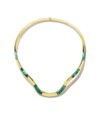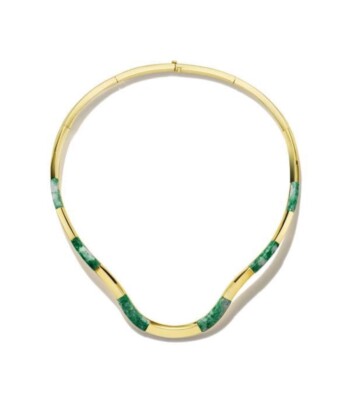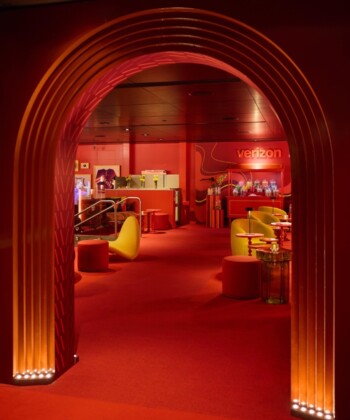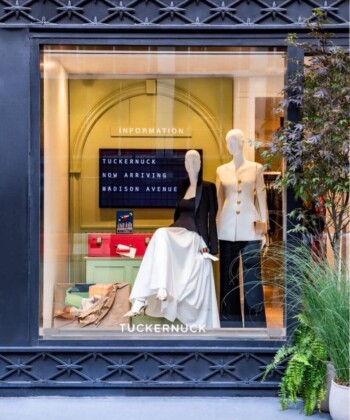When David Yurman decided to erect a new flagship store on New York City’s 57th Street, the task of designing the space fell to Evan Yurman, son of cofounders David and Sybil Yurman. As chief creative officer, the 37-year-old currently leads the brand’s men’s collection and important high jewelry pieces. He also works on the Artist Series, a collaboration with his father that transforms exotic gems into statement jewels with a luxe-meets-organic feel.
Helming the new flagship’s design, however, presented Evan with a unique opportunity to prove himself as a visionary.

Novella Mosaic XL cuff with citrine, pink tourmaline, and diamonds in 18-karat gold, exclusive to DY57, price upon request.
“I was inducted in the language of the brand from a young age, so the design codes and values are something that I understand innately,” says Evan, who has a background in blacksmithing, stonecutting, sculpture, and geology. He formally joined his family’s business in 2004.
Located just steps from Fifth Avenue, the 5,000-plus-square-foot space opened in December 2019. The architectural objectives were clearly defined: elevated craftsmanship, luxe materials, and innovation in design, while evoking modernity, warmth, and elegance. “We are first and foremost a design house, and this new home on one of the most important retail streets in Manhattan showcases the artistry and craftsmanship, engineering, and innovation of our products,” Evan says.

DY57 sketch by New York City architect Michael Gabellini.
The primary goal was to offer a state-of-the-art showcase for the full range of David Yurman jewelry and watches while encapsulating the brand’s unique artistic heritage. To achieve this, Evan collaborated with award-winning New York–based architect Michael Gabellini of Gabellini Sheppard. Having previously designed the DY Townhouse on Madison Avenue a decade ago (it’s now permanently closed), Gabellini was a natural choice for DY57, as the new flagship is known.
The Yurman family’s artistic roots are layered into the store’s interior design scheme. Examples of the work that David and Sybil were doing in the 1970s and 1980s—back when they were studio artists versed in welding, painting, and sculpture—are exhibited on the second floor. The iconic Cable bracelet, the original design that David created for Sybil in 1981, stands among them like a kind of mother ship in miniature, with its distinctive torque design and finial caps set with emeralds and amethysts.

Tanzanite ring with diamonds in 18-karat gold, price upon request.
Meanwhile, archival sculptures by David and walls adorned with mural paintings by Sybil further express the brand’s journey from art to jewelry. “A lot of my inspiration came from the fact that the product is rooted in materials, texture, and form,” Evan says. “So we strived to include special materials that give texture and that give a feeling of warmth and play with light.” A rose gold–colored facade, a dramatic French oak staircase, and flooring that arranges bardiglio trambisera marble and Pietra Cardosa limestone in a marquetry pattern are just a few of the elements chosen to create a considered mix of lustrous and matte surfaces.
Evan’s personal stamp is revealed in the furnishings, which hail from his own collection of Philip Arctander clam chairs and Heinz Lilienthal etched-steel tables, along with some Wegner and Eames pieces.

Amber Valletta at the David Yurman 57th street flagship opening event.
An entire floor is devoted to the men’s collection, the category that best reflects Evan’s voice and influence. The new EY Signature designs—one-of-a kind pieces that meld the allure of rare antiquities with modern, ropy chains—are a standout. “Some of my favorite pieces are the amulets featuring ancient gold coins that were struck and trimmed by hand in the 1500s through 1700s at Spanish mints in Mexico, Peru, and Colombia,” Evan says. These, and other collections that Evan has created, have a hand-hewn artistry about them.

Full pavé Renaissance drop earrings with diamonds in 18-karat gold, exclusive to DY57, price upon request.
The Waves Collection, for example, was inspired by the famous Japanese woodblock print The Great Wave Of Kanagawa by the artist Hokusai. Tendrilled gold waves stand out in stark relief against backgrounds of forged carbon on signet rings, shield-shaped pendants, and even a bracelet. “Over time, our product has evolved, both in terms of the engineering and technological processes used to create our pieces, as well as designing collections that feel new and surprising,” Evan says. Perhaps the best example of this is through an examination of the history of the famous Cable bracelet.

Statue of Liberty Cable bracelet with diamonds, exclusive to DY57, $3,500.
The newest iterations to embrace the motif are fashioned of slim, flexible 18-karat gold strands and finished with gemstones like emeralds, sapphires, and rubies. DY57 also has several store-exclusive versions of Cable: One is detailed in bronze with a greenish patina, a nod to the Statue of Liberty; finials are studded with triangular elements, alternately referencing the statue’s crown or the Chrysler Building’s Art Deco spire. “I believe what makes our brand special is that it’s about evolution,” Evan says. “It’s about: What is the next step? How do you not lose the past? How do you acknowledge the past and also bring it to the forefront of the future?”
How, indeed? Or maybe a better question is: Who will be the one to take us there? If DY57 is any indication, then we already have our answer.






































